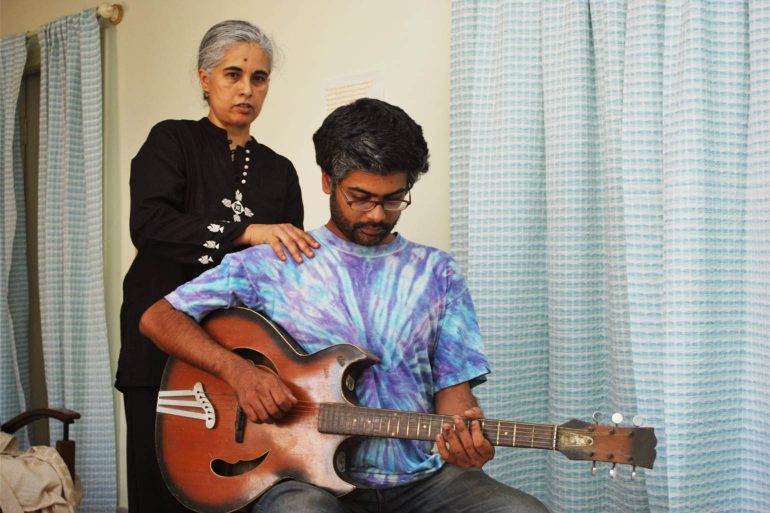Building Blocks is a fortnightly column by Jayasri Sridhar, a design student at the National Institute of Design. She brings the conversations from her college campus to this space, and writes about the issues and ideas that occupy the minds of students. Her first article, here, is a letter to her college campus about things she terribly missed while in the lockdown, and the second one is about the struggles of creating amidst news of war.
Padmini Menon, an independent fitness professional and Alexander Technique (AT) teacher, mentored postgraduate Furniture and Interior Design Students at the National Institute of Design as a visiting faculty for two weeks. Fredrick Matthias Alexander was an Australian actor, who found that he could only access his performing voice when he tensed up in certain ways, and knew he had to find a way to bypass that tension. He set up mirrors to observe his pattern of tension, and after a lot of observation devised Alexander Technique, which is still used by voice actors, stage performers, dancers and musicians.
NID’s Furniture department brought this module for the first time. At the end of the two weeks, students felt better equipped to look at human needs by listening to the body more consciously and understanding how it stores and releases tension, which takes their work far beyond the principles and codes of designing furniture in the conventional way.
When I visit Padmini in her faculty guesthouse room, her gentle aura strikes me as much as the effortlessness of her posture — she sat comfortably, cross-legged on her bed as we talk about her practice and the course she has just finished teaching at NID. This is her first time here, and I am eager to find out how were her interactions with the designers-in-the-making.
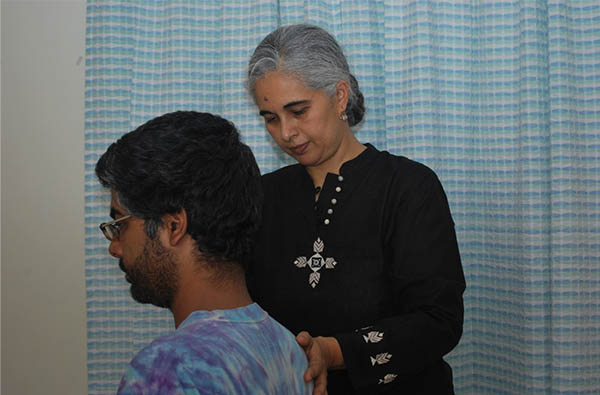
Read the edited excerpts from the interview here:
JS Could we begin with how you found the chairs in NID?
PM Oh, the chairs around here? They’re regular, standard ones you’d find anywhere, meant for public spaces. But you can make yourself comfortable in them if you know how.
[I’m a little taken aback, because these are exclusively NID chairs, designed by NIDians over the long history of the Furniture department, and it becomes clear why an outsider’s appraisal is valuable: it carries the knowledge of their own discipline, and lived experience. — JS]

JS So there’s a way to make yourself comfortable in every chair, if you know how?
PM Of course there is. Or at least, not too uncomfortable. There are some chairs which actively promote bad sitting, like the ones in railway station waiting rooms, for instance. They’re made of a single smooth sheet of metal, and make you slide forward. And if I’m not taking care, very soon, I’m sitting on my sacrum, my pelvis, which is very unpleasant on the back. Or I have to jam my feet on the ground to avoid sliding forward, which isn’t ideal either. So what I do is sit upright on the edge of the chair. So, yes, if you know what to do, you can handle all kinds of scenarios.
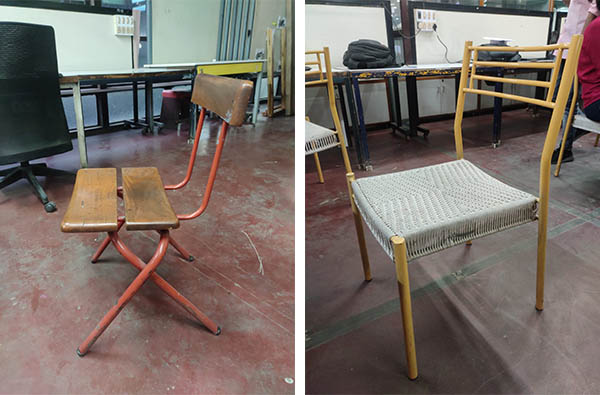
JS Could you talk about your practice? How did it all begin?
PM I’m an Alexander Technique teacher. I work with people to help them become aware of tensions they are holding without realising they are holding them. The last bit is important; we all are aware of some layer of tension, which we attempt to ease by relaxing or lying down, but there’s a deeper layer of it, which forms our lived experience. It dictates everything we do, without us knowing it. My job is to help people become aware of this tension, help them release it, and then use that skill and awareness to inform everything they do. It percolates into every aspect of their life. I completed a three-year course at Brighton Alexander Technique College in the UK. I teach students individually and in groups; there are athletes, homemakers, people of all ages.
JS What was it like teaching this two-week module at NID and interacting with designers?
PM It was interesting: I was initially apprehensive when Sweety [Sweety Taur, Faculty, Furniture and Interior Design at NID] approached me, because I’ve never done this before. People come to me with problems, and we work on them using the technique. But here, my role was not to teach the Alexander Technique per se, it was to introduce furniture design students to some of these principles, and then use them in whatever they were designing.
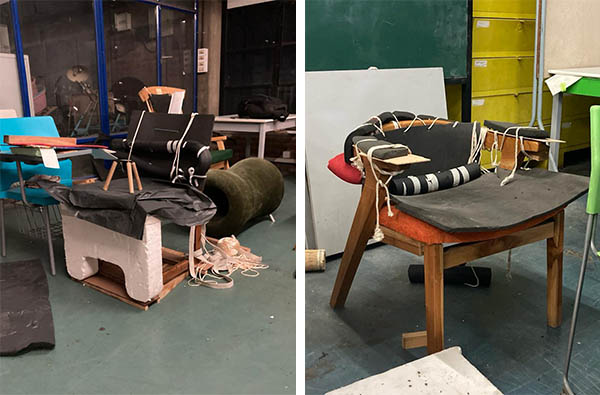
JS How did you go about the module?
PM I began with bodily awareness, an introduction to bones and joints and the structures that make up the human body, and how that would affect the piece of furniture that they were designing. The goal was to intersect the principles of the AT and their design sensibilities. We were clear from the beginning that a prototype was not a requirement, experimentation and understanding was the key. And being master’s students, I think they were quite quick in grasping the implications of what I was saying, and there was a healthy back and forth.
In a way, the principles are indeed simple. But on the other hand they’re not. They challenge a very deep layer of your habits.
JS I spoke to one of your students, Ashish Khaire, FID MDes 2020, and he mentioned the balance that must be struck between personalisation and producibility. He spoke of how they were modifying existing pieces of furniture around the studio to suit specific people as part of the module.
PM We did focus on how adding or removing parts could make furniture promote better posture and comfort.
JS The word he used was ‘tailor-made,’ and it was interesting to see all these chairs and benches augmented with pieces of wood and textile surfaces tied to them to make them better suited to the user in question. But the sheer scale of that to be done for a larger population also made me wonder if the principles of the Alexander Technique are accessible in a way that you tell someone and they can apply it in their own lives.
PM In a way, the principles are indeed simple. But on the other hand they’re not. They challenge a very deep layer of your habits. For instance, when I started learning, I realised my natural posture was slightly leaning forwards, and that felt balanced to me, though it was bad for my body. And so when you begin to correct that, your body tells you this isn’t right. That’s the strong response your system gives you. I felt off-balance. And that’s where the teacher comes in, to help you get through that initial stage of discomfort and disorientation as you unlearn ingrained habits. They carry you through the phase of strangeness, so it doesn’t become a stopping point. But the principle itself is quite simple, for one — Before you do anything, pause. Take a moment. Think. Allow yourself to release, and then do it. That’s it; it’s just that it sounds simple, but it’s not: It’s really difficult to catch that layer of awareness.
JS We’ve spoken so far only of the material side of this environment, though. Half of us are communication design students. Do you think that working with disciplines such as graphic, film and video, exhibition, animation, etc might bring about an intervention in spreading awareness more effectively?
PM I would love to work with anyone I can! Definitely, communication designers could play an exciting role in making people aware of this technique. In fact, when I look around, nothing truly is exclusive of this, I’m always looking for ways to integrate any discipline with the Alexander Technique.
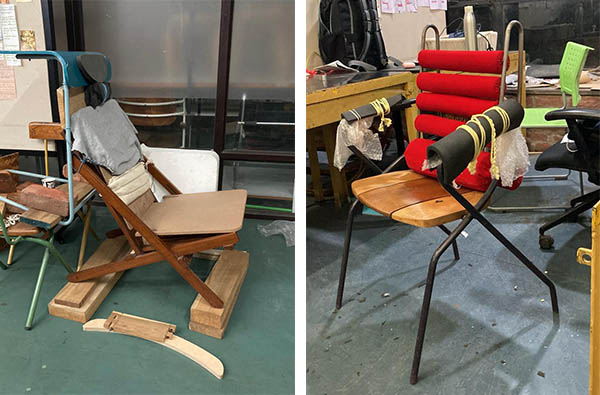
JS You mentioned that Alexander was a stage actor?
PM Yes,
JS Are there formal or fixed principles to this method?
PM There are some, but no fixed rules. The basic rule is that you learn to access these deep patterns and then let go of them. One favourite area is releasing tension in the neck, because it’s a crucial region. There are also AT teachers who do it differently; there are a few basic guidelines, but you can do it in your own way.
The module was also about understanding that beyond a point, your role will end. And people will do what they do. But up till that point, you can design for that ideal.
JS Ashish also mentioned how your voice was insightful as someone who was not preoccupied with the design aspect of doing things around here, and how your module focused more on the human side of things. What was it like to bring a non-designer lens/critique to the work that goes on here?
PM There seem to be certain rules within which they operate. In chairs, there are dimensions, ergonomic measurements, and so on, and a designer works with that. What I tried to do with these students was asking them to work with one person, and we looked at what their setup was encouraging this one person to do. As designers, can you create things, anything, that encourage people to sit well, stand well, or walk well?
JS You’d think that ergonomic principles would aid the making of things that enable that.
PM They don’t. A lot of these principles are also vague and not universally agreed upon. Every body is different. There cannot be a one-size-fits-all solution, but designers can come close to enabling better interactions with products and structures. The module was also about understanding that beyond a point, your role will end. And people will do what they do. But up till that point, you can design for that ideal.
JS What are you taking back from here?
PM Oh, working with this new focus, this slightly off-centre one was a really interesting experience. Working with designers interacting with these people and interjecting with ideas drawn from the AT to inform the process of designing a chair — I’m taking back these thoughts and this new angle, maybe I will write an article for our professional magazine. Besides that, I’m taking back Gujarati snacks. (laughs).
***
Jayasri Sridhar is a Film Design student at NID Ahmedabad with a passion for research, poetry, Hindustani music and deep conversations. When she’s not doing riyaaz, she’s found either around a bookshelf or journalling away about how she loves too many things for her own good.

